Name: Grandia
Publisher/Developer: Game Arts Co., Ltd.
North American Release: October 28th, 1999
Platform: Sony PlayStation
Before we get into the new article: if you like the reviews and Gold & Steel in general, a great way to help this page is to either buy our books from Amazon or Buy a Coffee! It’s the sure way to ensure that the content you like keeps flowing. Thank you for reading and supporting the page, and with that, let’s get into it.
I got a question for you: If you were a JRPG fan in 1999 and you didn’t have a PS1, what were you playing? Sega’s two, separate disc consoles, the Saturn and the Dreamcast had a small handful of RPGs between them, notably Sega’s own franchises Shining Force and Phantasy Star. Nintendo 64 had exactly one at that point in Quest 64, (the console would get a whopping three more before the N64’s end) and beyond that, well, the only other new source of RPGs was the GameBoy Colour. I’m not kidding you, at the height of the PlayStation/Nintendo console war, Nintendo dropped the ball hard for JRPGs on their home console. Cartridges are the main reason for this, and Nintendo’s insistence on using them drove RPG publishers straight into Sony’s waiting arms.
The N64’s carts were far more expensive to produce than PlayStation’s CD-roms, but that was merely one issue, as their storage capacity and audio quality were also severely hampered. For some games, like 007: The World is Not Enough for instance, these issues could be circumnavigated, and it and a few other titles managed to appear on both consoles. If you read my last piece on WCW and WWE Wrestling games, you’ll see quite a few titles, like WWF War Zone and WCW Mayhem that also appeared on both the PS1 and N64. Sports games and First Person Shooters could do that, though and there was often little change between ports. I mean, sure, the PS1 version of say, WWF Attitude, had full motion video and CD quality tracks that the Nintendo 64 entry definitely did not, but for the most part, the two iterations played identically, even if the game itself was not overly good to begin with.
For RPGs, though, the capacity of the N64 carts didn’t allow for much room to let your story or its setting grow. At least with the PlayStation, you could simply let it carry over onto a second, third, or even fourth CD. Can you imagine a Nintendo 64 game shipping with more than one cart? The retail price alone would have made it unfeasible because you can be damn sure that they would have to account for that. In the face of that, the options for developers of RPGs on the N64 were, well, stuff like Quest 64.
The Nintendo 64 did have its share of good games in other, JRPG-adjacent genres, though. I mean, the two Legend of Zelda games alone made the console worth having. The Legend of the Mystical Ninja had two great outings on the N64, Harvest Moon 64 is a joy and a half, and Hybrid Heaven was a great game with RPG elements. Ogre Battle, of all franchises, had a strategy RPG that’s one of the most valuable carts for the console today. Paper Mario, released in 2002, was a great RPG that almost served as a sequel to Super Mario RPG, or at least it was a sequel in spirit, with a few similar concepts. It was a Nintendo entry, though. If anyone could come up with a good RPG on their console, it would be the company that knew how to work with the console’s limitations. Indeed, it would be slim pickings for Nintendo this time, which is surprising when you consider that the Super Nintendo was the JRPG destination just a few short years before.
If you had a PlayStation in 1999, though, a galaxy of fantastical and far off worlds were at the waiting to explore. Not counting the back-catalogue of RPGs already on the market for the PS1 in North America at that point, 1999 was a remarkable year for new releases. In that twelve months alone, we saw Legend of LeGaia, Final Fantasy VIII, Thousand Arms, Star Ocean: The Second Story (a personal favourite), and Suikoden II (another personal favourite). It even marked the first time that a legitimate version of Final Fantasy V hit North American shores when Squaresoft released the Final Fantasy Anthologies collection, which came bundled with the masterpiece that is Final Fantasy VI. That’s just the tip of the iceberg, too. This was undoubtedly a golden era for RPGs, especially in North America, when we were finally seeing titles released here that would not have seen the light of day in the SNES/Genesis era.
Among that Class of ’99 was a curious little JRPG that stands out among the rest, and I do mean to say that as though it’s an anomaly. That’s because this particular game had already made it to market in Japan a whole two years before reaching the PlayStation and for an entirely different console.
I’m talking about Grandia.
Grandia was originally a Sega Saturn release in Japan, having hit their markets in ’97. Normally, games made in Japan that had an expected North American release would do so roughly a year later to allow translators and programmers time to convert the game for English audiences. These same games almost always then hit North American shores for the same console that they started on in Japan. So why then did Grandia first start off on the Saturn in Japan ’97 and turn up on the PlayStation in North America in ’99?
Game Arts’, the company behind Grandia, had a fairly limited history outside of Japan up to that point. They had only two games released in North America for the cartridge consoles: Faria: A World of Mystery and Danger! for the NES and Alisia Dragoon for Genesis, with the former being an RPG, and the latter a platformer with RPG elements.


Faria, at least, contains many artistic and gameplay elements that would become staples of Game Arts’ style going forward and it was a well-received, yet overlooked, RPG for the console. Still, the company wanted to do more than what cart consoles at the time could offer. You see, Game Arts wanted full-motion anime in their games, and voice actors to help bring their characters to life, and those characters had big, epic tales that Game Arts they wanted to tell. To convey these stories to the home console audience in the early 90’s, Game Arts knew that they needed CD technology to get the job done.
So who was the first major home console provider to offer such a product? Why no, it wasn’t Sony, as they were only fiddling around with ideas with Nintendo at the time. It was Nintendo’s original main rival: Sega.
What that Sega Genesis (or Mega Drive, as the rest of the world knew it as) is sitting on is the Sega CD, which was not a standalone console, but an add-on to the Genesis. The Sega CD was the first to bring CD technology to gaming audiences, and Game Arts was all over it. This was the answer to their problems. Game Arts was going to be the cutting edge game developer that brought anime and JRPGs together in a way that companies like Squaresoft and Enix could only dream of doing.


A valiant effort was made for their first attempt, and the result, known as Lunar: The Silver Star did break many a barrier in JRPGs that franchises like Final Fantasy wouldn’t touch until the mid-to-late 90’s. However, the Sega CD, while powerful for its time, was already a few steps behind Game Arts’ lofty ambitions. Despite the Sega CD’s limitations, Lunar: The Silver Star was still a ratings hit, receiving near-perfect scores across the gamut of reviewers. In Japan, it sold almost as many copies as the Sega CD add-on itself, and remains the second best-selling title for the system, outdone only by Sonic the Hedgehog CD. Game Arts kept on telling their epic fantasy saga on the Sega CD, releasing a follow-up called Lunar: Eternal Blue in North America in 1995. It improves on the first, but still, the Sega CD was having trouble keeping up with Game Arts’ vision.


While working on the Lunar games, Game Arts managed to churn out a few other projects like Sim Earth and Wing Commander, which even saw cartridge console releases. They also took on a new JRPG project that they initially intended to be released for the Sega CD, just like Lunar. Somewhere along the way during development though, those limits that the Lunar games were hitting began to crop up again. The new project was just too much for the Sega CD to handle. Not all hope was lost though, as Sega just so happened to have their shiny, new stand-alone CD console ready to go, and that bad boy had way more power than the Sega CD.
Game Arts took one look at the specs for the Saturn and said, “Port it!” and their team got to work doing just that, finishing Grandia and releasing it to Japanese audiences in December of 1997. RPG enthusiasts in Japan ate it up, and the Saturn version sold 344,554 copies in its Saturn iteration, making it the fifth best-selling game for the console in Japan. Sega were thrilled with these sales figures, and the rave reviews from industry writers and fans alike were resonating loudly in their home country. All that enthusiasm and a pile of screen shots managed to be found all the way across the Pacific in the form of magazines like GamePro and Electronic Gaming Monthly.


North American JRPG fans wanted to be able to play Grandia on their Saturn consoles too, and a fansite for the Lunar games even started a petition to get it brought to the continent.
With all this support for Grandia to make the leap, Sega listened intently, and responded to eager fans with a loud, resounding, “Nah, we don’t feel like it.”
Despite Sega’s nonchalance towards the idea, Game Arts felt differently, and wanted nothing more than to bring Grandia to new audiences. If Sega didn’t want to do it, then Game Arts was going to find a company that would. While Sega’s brass didn’t believe that Grandia would be viable outside of Japan, and Nintendo’s insistence on cartridges rendered them unable to host the game, there was still hope for Game Arts.
Sony and its PlayStation console, which at that point was trouncing both the Saturn and N64 in North America, was the ideal home for Game Arts’ biggest hits, plural. That’s right, Sony wanted more than Grandia. Game Arts landed on a deal that saw them port enhanced, 32-bit versions of the first two Lunar games in complete form to the PlayStation, starting with Lunar: Silver Star Story – Complete in June of ’99. Four months later, Game Arts followed that up by delivering their new major RPG project to North American audiences at long last.
It may seem in retrospect that Grandia made a quiet entrance outside of Japan, and its sales records seem to reflect that, but in reality, it was indeed a hit amongst the JRPG genre enthusiasts. For a JRPG, in what was a robust market at the time, selling 97,460 copies in the U.S. in its first three weeks is nothing to scoff at. The ratings only bolstered the sales, as magazines such as the aforementioned GamePro and programming like The Electric Playground (now known as EP Daily) were giving it the sort of top marks that were usually the domain of Squaresoft’s offerings.
Still, despite this hype and praise, and my own enjoyment of JRPGs, Grandia was a game that somehow managed to slip under my radar. It’s a game I would see every once in a while at the game store I still frequent to this day, but there was always something else to get my attention instead. In fact, it wasn’t until last year that I finally picked it up, at that same game store, in fact. It was the first time I could recall seeing the game in years, and it was one that was on my list to get and play (as are most JRPGs for the PS1 that I don’t already have) and well, there it was, so I said, “Might as well get it while it’s there.”
Let me tell you all something though: am I ever glad I did. One of my favourite things about JRPGs is their ability to spin a narrative as engrossing and satisfying as the fantasy tomes that inspired the medium. I love it when I finish a book and days or even weeks later, I’m still thinking about it. A number of JRPGs have had the same effect, and Grandia was one of them.
That seems as good a segue as any to get into the story. Spoilers ahead. To avoid, skip until you see the bolded text reading “End of Spoilers”.
The story centres around the player character, an adolescent boy named Justin living in an industrialised world that seems to be a mixture of the old world and the modern world, with more emphasis on the modern side of things. Justin lives a pretty carefree life in the town of Parm. In fact, we start off the game innocently enough with Justin being challenged by his rival to find the armour and sword of a legendary hero that the rival has hidden all around one half of the town. It turns out that this “legendary” equipment is comprised of household items like a pot lid for a shield, and their legendary status is conjured from the vivid imaginations of a bunch of creative youths. Regardless, our intrepid hero, with his friend Sue, and her flying fluffy pet Puffy, take to their “quest” with a gusto that sets the bar for everything that follows.
You see, Justin dreams of following in the footsteps of his long-lost adventurer of a father and pursuing the ideal, romanticised life he imagines his old man had prior to his disappearance. Justin’s mother, a former adventurer and pirate in her own right, disapproves of that lifestyle, but proves incapable of stopping him. I mean, she would have to fail at that task or otherwise it would be a damn short game.
Anyway, Justin and Sue begin their adventures by sneaking amongst the site of some ancient ruins near Parm that are currently being investigated by the military body known as the Garlyle Forces. As the game goes on, this army, and their leadership in particular, will serve as the primary antagonists of the game. The important part of Justin’s trip to the ruins is not his run in with the various Garlyle officers, but it does prove entertaining. Instead, the main purpose of the visit is for the ruins to serve as a conduit between Justin and a mysterious woman known as Liete. This woman, who is literally shrouded in darkness, implores Justin to seek her out in the far reaches of the world, where he will receive the answers to all life’s questions, including the fate of his father. This crossing with Liete convinces Justin that his career as an adventurer is to be pursued, and he endeavours to do just that. With the help of a veteran adventurer who is getting on in age (but don’t call him retired), Justin gains a passport that will allow him to leave Parm via ship for New Parm. There, explorers and adventurers alike are said to convene before they embark on their personal journeys to discover the new continent and forge their paths to the mysterious lands within.
The story begins in earnest then, and we begin to meet a robust and colourful cast of characters from across the whole gamut of fantasy races and species. On his ferry ride to New Parm, Justin and Sue (who stowed away after Justin told her she was too young for adventuring) meet Feena, an adventurer who has seemingly accomplished enough in her fifteen years of existence to achieve a level of worship among wannabe adventurers like Justin.
Feena eventually joins your party, and permanently. As you traverse the game world, you meet other party members who might join you for a brief time and two more that will join on a permanent basis once your paths cross. This cast brings together a variety of peoples that includes a brawny, stoic swordsman; a bargain-hunting salesman of the rabbit-like Mogay people; an Amazonian-esque elven farmer woman; an ill-mannered, rebellious elven young man; and a demi-goddess with near-infinite knowledge but striking naiveté when it comes to social interaction. Quite the eclectic bunch, eh? Try to guess the two among them who are the permanent party members. You might be surprised.
That ragtag group and a host of supporting characters, and even the decidedly grey-area antagonists all form the basis for a narrative that spins a pretty wild tale. Justin starts his journey as a blissfully ignorant youth with a glamorised idea of what it is to be an adventurer. As the story goes on, both he and Sue see their notions of such shattered, and reality hits them hard, both physically and mentally. Feena, who had more experience in that area than either of the other two, is torn between opposing her only known family member and doing what’s good for the world as a whole. As the past, both personally and on a global level, is uncovered, and the motives of the antagonists are fleshed out, Justin and his friends grapple with increasing internal and external issues. The ordeals of the heroes eventually just becomes too much for one character, and they have to admit to finding their limits and head home.
It should be said that in this game, that home has never felt further away. In many RPGs that came both before and after Grandia, the world map feels like a giant sandbox to be explored at either your own pace (like in say, the Elder Scrolls games) or at the pace of the narrative. (Think Chrono Trigger or most Final Fantasy games) Somewhere between the mid-point and the end of the latter type of game you typically get a vehicle, creature, or teleportation spell/device that enables you to travel quickly over most or all surfaces, opening the map entirely to the player and allowing it to be crossed in every direction in seconds.
The creative team behind Grandia, though, really wanted to land the adventure aspect of the game. To do that, they decided that there is no going back. Every step Justin and his friends take is one step further away from where it all started. When you leave Parm, all the characters there, from Justin’s peers, to his mother, and the kindly museum keeper who puts up with Justin’s shenanigans, and even the elder adventurer, will never be seen again. You simply move on to the next area, with usually a town or two as a hub for supplies, and the next part of your path ready to explore. Once you cross the mountains, fields, and forests within, that hub too, is left behind for the next, and so on, until you reach the game’s end, with no looking back as you go.
As a story-telling technique I appreciated it immensely, as it really made it seem as though Justin and the others truly trekked a long way to get from where they began to where they ended up, exhausted and forever changed. It also made the world, which is relatively small compared to other JRPGs of that time (like the first Suikoden and Final Fantasy VII, which were both made at about the same point as Grandia) seem huge, as you felt as though you were walking right alongside Justin and his friends through each area, rather than seeing them as a tiny sprite on an overhead map or zipping about on an airship.
On this long and winding journey, Justin experiences first-hand the struggles of those of whom the Garlyle Forces (an unyielding force for greed) deems to be in the way. Though Justin attempts to help the many communities and peoples affected by Garlyle’s actions, he has to accept that not all battles can be won, and he has to deal with the lows of his desired lifestyle that in his childishness, he never considered possible before.
For what it’s worth, I felt that the writers of Grandia dutifully juggled all of the above and barely, if ever, made a questionable move. The whole thing, from the world building, the overarching plot, and the characters’ own narratives, all comes together in one neat package that, when it wraps up, feels complete.
Of course, that complete package can’t come about without the gameplay to get you there, and Grandia excels in that regard as well.
**END OF SPOILERS**
Before we move on, this seems like as good a time as any for me to shamelessly plug my own fantasy offerings. Thus far, I’ve written two volumes of The Gold & Steel Saga alongside a companion collection of short stories. Gold & Steel is a flintlock/industrial-era fantasy starring a varied cast of characters on unique, albeit intersecting journeys to bring about a new day in their country of Illiastra. If that catches your fancy at all, click on any of the book covers below to be taken to their corresponding Amazon.com page.


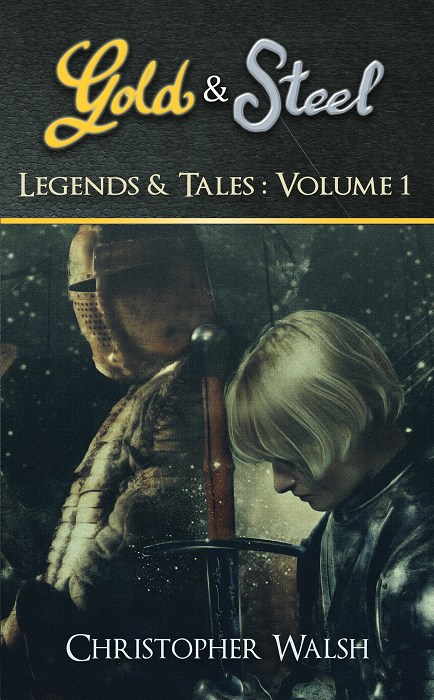
Thanks for looking, now back to the review!
Grandia’s gameplay can be broken down into three parts, the first and most simple is the overworld map as described earlier (which made me think of Illusion of Gaia, admittedly, which you can read my review of in the link over there ). Once you select the location you want to go, you’re then brought to an overhead, isometric area, such as a town or passage. From there, we get into part two of the gameplay. Once in your desired location, the experience is like about 95% of JRPGs. You can move in all directions and press a button to interact with the objects and characters around you, hold another to dash, and lastly, there’s a button to display the menu screen. The camera is free roaming, meaning you can manipulate it to face whichever direction you want from the isometric angle. There are some puzzle elements to it, nothing too complicated, but it all works with the standard “press the button to interact” stuff. All of it handles perfectly fine, and there’re no complaints to be had.
Second part of the gameplay is the battle system. As seen in games like Final Fantasy Mystic Quest and the Chrono duo (you can read my review of Chrono Cross here), enemies visibly appear in the various uninhabited locations you visit, and battles only commence when you touch the enemy in question. Many baddies will actively pursue you, so while you have the option to avoid them, they make it difficult to do so. Some though, will stand perfectly still. On that note, if there’s one piece of advice I give you it’s do not skip any regular enemies. You won’t get any extra points for clearing a screen, (such as in Illusion of Gaia, again) but the motionless and evasive enemies tend to drop more experience and rarer items.
Now, as for the battles themselves, that’s where the game really shines. It takes the same overhead, isometric approach as the regular fields, and operates in a turn-based style familiar to any JRPG player. That’s where the similarities end. The characters and enemies populate on the battle screen in a form that’s slightly randomised, meaning that unlike in say, Final Fantasy’s I through X, friend and foe are not lined up across from one another. Your party members could be within a foot or two of enemies, or several feet away. They might be near your other members (likely) or you might be in a pincer position, or a mixture. This matters, because also unlike other JRPGs of the era, the enemies freely move around the map and will try to get as close as they need to for an attack. As you input your own characters’ commands, they too will move around the map as they carry out those commands (though you can’t move them to specific locations, it’s not a strategy RPG, after all).
It puts an entirely different strategy on things, as you have to take into consideration where everyone is when inputting your commands. You don’t want to force say, Sue, who is magic oriented and low in defence, into a position where she’s going to get cornered by enemies. At the same time, you do want enemies to cluster together near-ish to her so she can hit them with magic that hits a wide area and can damage multiple enemies at once.
Speaking of magic, Game Arts deserve kudos for how well the magic system is implemented in Grandia. Have you ever heard of the old debate of how every rock/metal/alternative band since the 60’s can be classified as following either the Beatles or the Rolling Stones? Well, I have a system of my own for classifying JRPGs: magic or melee? For example, the first Suikoden is definitely melee heavy. There’s a magic system, but mages always have a fairly limited number of spells at their disposal and replenishing is not always easy in dungeons. However, at nearly any point in Suikoden, you can power through with a party of short and long-range fighters. On the flipside for magic heavy is the first Final Fantasy. There, of the three melee fighters the Fighter is good in the beginning, but his gear is expensive, though he at least remains useful; the Thief is generally junk; and the Monk is deadly when unarmed but has worringly low defence; yet, both a white and black mage are essential party members and get damn near godly by the end.
Everyone’s rankings of whether a game is magic or melee heavy are going to be different, and by all means, discuss it here in the comments or wherever you find this article shared on social media. For the sake of this article, I digress, though, and the point of me bringing it up is to say that when I played Grandia, I was hard pressed to decide which way it leaned. Even now, I can’t pick a side for it. The gameplay is balanced that well. I mean, magic is highly useful, but it’s not super plentiful; meanwhile, melee combat works great for all but about two characters, and only one of those is permanent. Most of the temporary characters don’t even use magic, but the permanent members are so well rounded in what they know and can learn, that they make up for it with their wide assortment of spells. The development team played this quite tightly, and as a result of that balancing of the characters’ abilities and magic in general, the game never feels cheaply unfair and the challenge in most boss battles is always right on the nose.

That brings me to the next point: the game isn’t grind-heavy. So long as you take the time to fight the enemies you naturally encounter, you shouldn’t feel the need to go for too many subsequent rounds in each dungeon. Maybe for the coinage, if you’re short on supplies, or to put your characters over the top if they’re near a new level, but you won’t feel a need to do that overly often. Now, I will say that levelling up is a slow process once you get to about the midway point. You’ll need continually more experience and there are times when certain enemies in a given area will give little, but others in the same area will give exponentially more, so you’ll feel the need to come back and spend some time picking off respawns of those particular enemies while avoiding the weaker ones. Still, it’s not a boring grind like a few JRPGs of that era were. When I was younger, grinding wouldn’t bother me too much, but now, I feel a little more cognizant of the flow of time, and I don’t want to spend hours trying to get a few extra levels so I can beat a purposely-overpowered boss. Some people enjoy it, and as I said, I was once among you, but now, it just feels like a cheap tactic to inflate the game’s length artificially, and, as we say in Newfoundland and Labrador, “I’m not going at it”.
Mentioning the bosses brings me to my one major issue I took with this game. Perhaps it was an issue with my discs, but neither one bears anything more than minor surface scratches. Furthermore, I am willing to consider that maybe some part of my PS1 is giving out, yet other games in my collection play without issue whatsoever, so it’s hard to say for certain. However, the issue is quite isolated, so I’m sceptical that the hardware is to blame. You see, starting at about the midway point of disc one and amplifying to previously untold highs in disc two, the boss battles would play out painfully slow. No, they weren’t just slow paced. What happens is that the music would outright not work, the PS1 could be heard whirring madly, as if attempting to load data, and the battles slowed to a frame-by-frame rate whenever any action was happening on the screen. I could access and select options from the command menus without issue, but as soon as I entered those commands and the characters went about their business, the frame rate would utterly collapse upon itself again. Again, this was only for bosses, regular encounters worked just fine from start to finish.
That’s the weird thing. It could be more readily understood to be a disc hardware problem if all the battles were slowed down, but the issue is so specific to boss battles and carries across both discs of the game, with it getting worse as bosses get bigger and more complicated. Even more strange is that the final boss in their multiple forms worked just fine. See, it’s that sort of thing that makes me hesitant to blame the hardware. Still, that glaring problem couldn’t keep me from enjoying this game, that’s how good Grandia is.
“But how does it look, Chris?”
As you can see from all the screen shots I keep dropping, it looks like a typical sprite-based mid-to-late 90’s JRPG. Given what Game Arts was known for in using the anime style in this genre going all the way back to Faria, they stuck with it for Grandia and went with a vibrant colour palette to suit the exuberant personality of the game. The 2D sprites on the 3D surfaces work fine, the few polygons that show up in the terrain and a handful of interactive objects look a little blocky, of course, but that’s par for the course for this era of gaming. But then again, if you’re going into a game from the 32bit/64bit era looking for graphical excellence, you’re looking in the wrong place. This was a generation of games that were decidedly rough when 3D got involved. Grandia’s team continued their balancing act by trying to find a happy medium between the shiny new 3D that Nintendo and Squaresoft were doing and the 2D that games like Donkey Kong Country (which I also reviewed) were utilising at the end of the 16-bit era. Personally, I thought Game Arts did just that wonderfully. The sprites are all animated well, and have a multitude of poses to act out each scene and battle. Where that hits its limit, the text for the named characters is all accompanied by photos of each. The main characters and the most expressive side characters all tend to have a wide variety of differing headshots that help to convey the emotion of what’s going on. It’s details like that I appreciate, and they go a long way toward telling Grandia‘s story.
The last element of storytelling in Grandia to touch on is the soundtrack. Noriyuki Iwadare is the composure credited here, and his resume includes the Lunar games, the subsequent Grandia games, a few instalments in the Phoenix Wright series, and Kid Icarus: Uprising, to name the hits. I enjoyed his work here with Grandia, and I thought the battle themes in particular were standouts. (When they played) In particular in that vein is the track playing when you duel with Gadwin, the muscle-bound swordsman who would undoubtedly be played by Dave Bautista in a movie adaptation.
Iwadare keeps the soundtrack as bright and delightful as the colour scheme of the art directors. Many of his tracks, like the main theme below, evoke the grand sense of adventure that every other part of Grandia instils.
Most of the soundtrack follows with a matching level of vibrancy and grand (play on words intended) nature. Yet, when he needs to, Iwadare can bring the feels too.
For my money, though, the following track is the highlight. Months later, this is the one that still sticks in my head. I just think it’s a brilliant piece, and I enjoyed it every time it came back around in the game. It doesn’t hurt that you get this song at what is a moment that the first half of the game was steadily building toward, so when it hits, it comes at the exact moment of triumph for the characters. I also enjoy the fact that the song is one of several distinguished parts. It’s as much an adventure as the game itself.
Is the soundtrack going to stand out overall? Well, some of the tracks that play in the various ruins you visit don’t do much for me, in fact, I had to go back just to remember what they even sounded like. One was overly repetitive and got me excited just to finish the dungeon so it would stop, but it was the exception rather than the rule. However, the remainder of the soundtrack is memorable and definitely noteworthy. It may not rank among my absolute favourites, though. One thing I enjoyed about the soundtrack is that even in moments where the track intends to build tension, it never strays from its adventurous vibe, and even stuff like the Ghost Ship and the (optional) Illusionary Castle feel as fun as a Saturday morning cartoon.
Iwadare brought a lovable charm to this game, and it seeps through every moment. It’s a delight and you should check the whole thing out online, especially if you’re a writer and you want a soundtrack for writing your own classic adventures.
So that’s Grandia and if I failed to give the impression from the article, let there be no doubt that I give it a full recommendation. It’s a bit tricky to find in physical form for the PlayStation, and usually goes for somewhere between $80 and $100 in Canadian dollars. However, if you want to play it on something more current, it’s available in a HD remaster for download for PCs and the Nintendo Switch. So, give it a go any way you can.
In case you missed it at the top of the page, here’s our Amazon and Buy a Coffee! links to help support Gold & Steel.
Have a good one and stay safe out there!
*Images sourced from Moby Games and GameFAQs

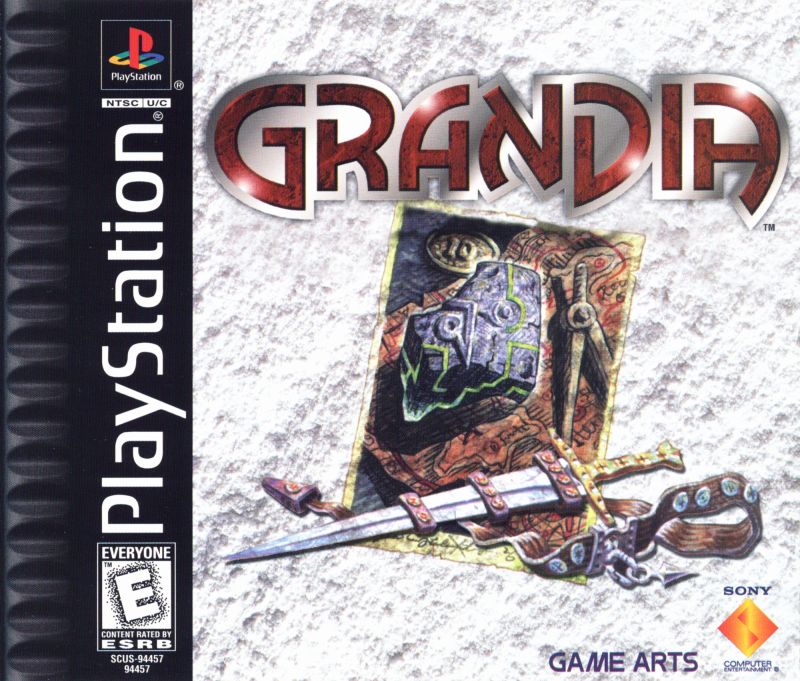

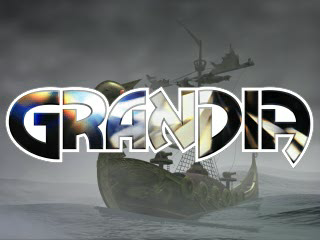

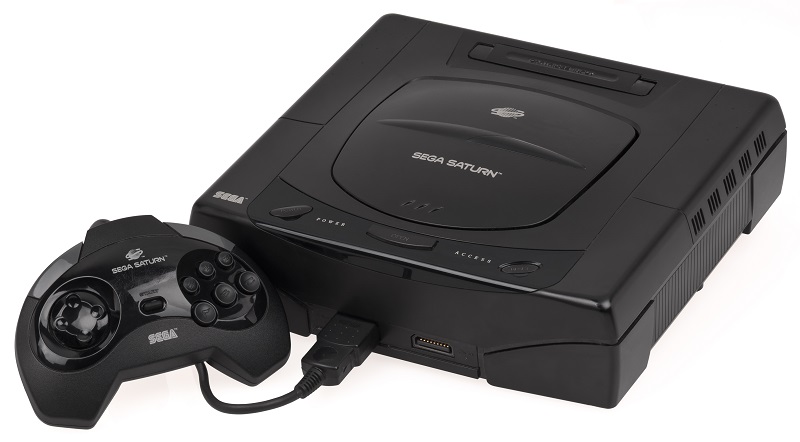

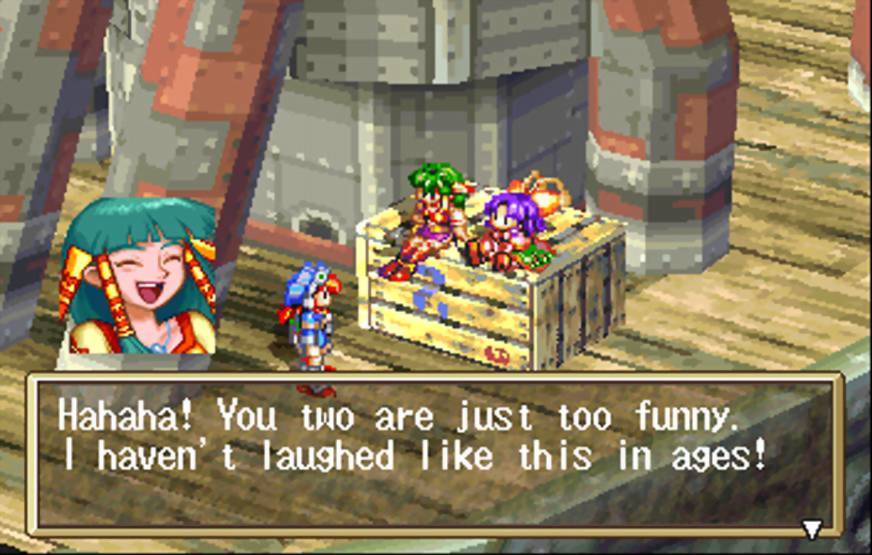
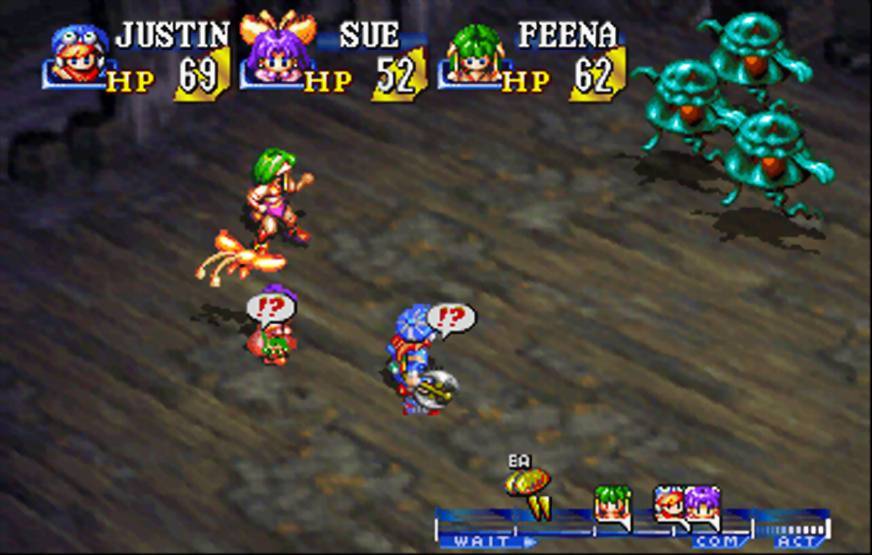

Leave a comment